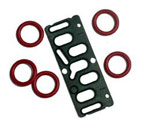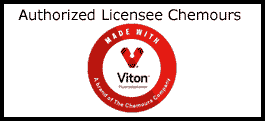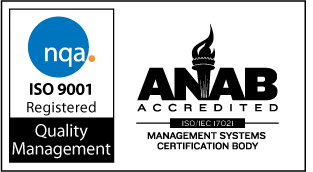
|
7108
S. Alton Way, Unit I |
(303) 758-2728
Home > Viton > FKM Fluorocarbon Lasts Longer
Viton™ O-rings and Seals Last Longer

Viton o-rings and seals can help you reduce your lifetime costs by preventing seal failures, extending maintenance intervals, handling more aggressive fluids and higher temperatures, increasing safety and meeting stringent environmental regulations.
Reduce Your Lifetime Costs
Viton o-rings far outlast o-rings made from nitriles and other general-purpose elastomers. That means you can extend service intervals and stretch maintenance budgets. Viton has excellent mechanical properties, resistance to extrusion, resistance to chemicals and heat, retention of elastic properties over time and excellent resistance to atmospheric oxidation, sunlight and ozone.
Cut Unscheduled Downtime
Viton o-rings and seals are so reliable they will help protect against unscheduled downtime. If you offer warranties on your products, you can extend the warranty periods with confidence.
Increase Temperature Capability
In many applications, rubber parts are stressed by accidental temperature excursions as well as by increases in operating temperatures designed to increase production. In some situations, Viton o-rings can serve continuously at 204°C with excursions to 315°C.
Resist Aggressive Fluids
Viton o-rings perform well in a wide range of aggressive fluid environments. They can tolerate changes in fluids and have more versatility for broader application.
Comply With Tougher Regulations
Environmental regulations have raised the stakes for leaks, spills, and emissions. Viton o-rings and seals help guard against these problems by improving manufacturing and automotive operations.
Proven Performance
Since its introduction in the 1950's, Viton o-rings have solved sealing and other problems in major industries:
- Aircraft and Aerospace
- Automotive
- Chemical Processing and Transportation
- Off-Highway and Heavy-Duty Equipment
- Petroleum Refining and Transportation
Major
uses of Viton o-rings include bonded seals, radial lip seals, caulks,
coatings, vibration dampeners, expansion joints, gaskets, o-rings, piston
seals, custom shapes, and stock rod and sheets.
A
Tough Contender
The compatibility of Viton with some important chemical media is shown in the table below. The capabilities of other elastomers shown for comparison can be helpful when you are considering changing materials to increase reliability or accommodate more severe operating conditions.
Viton also offers mechanical ruggedness so o-rings, seals and components resist damage during installation and use. Basic mechanical property data listed show that Viton compares favorably with other elastomers in tensile strength, range of hardness and resistance to compression set.
Viton retains sealing force to prevent leaks even after compression for long periods in severe environments. After 100 hours in air at 150°C, it retains more than 90% of its original sealing force, while o-rings and seals of fluorosilicone, polyacrylate and nitrile retain only 70, 58 and 40% respectively.
Viton has excellent resistance to atmospheric oxidation, sunlight and ozone. After 20 years of exposure to direct sunlight, o-rings and seals of Viton showed no traces of cracking. Also, Viton did not crack after one year in an atmosphere containing 100 ppm ozone.
| Common Name |
Neoprene
|
Ethylene
Propylene |
Nitrile
|
Silicone
|
Fluoro-
silicone |
Viton
|
Kalrez®
|
| Chemical Compatibility1 |
|
|
|
|
|
|
|
| Lubricating and Fuel Oils |
2
|
4
|
1
|
4
|
1
|
1
|
1
|
| Hydraulic Oils |
2
|
4
|
1
|
2,3
|
1
|
1
|
1
|
| Fireproof Hydraulic Fluids |
2
|
1
|
3
|
3
|
4
|
4
|
1
|
| Vegetable Oils, Animal Fats |
2,3
|
2,3
|
1
|
1,3
|
1
|
1
|
1
|
| Gasoline (high octane) | 3,4 | 4 | 1,2 | 4 | 1 | 1 | 1 |
| Kerosene | 2 | 4 | 1 | 4 | 1 | 1 | 1 |
| Aromatic Hydrocarbons | 4 | 4 | 2,4 | 4 | 2,3 | 1 | 1 |
| Aliphatic Hydrocarbons | 2 | 4 | 1 | 4 | 2 | 1 | 1 |
| Alcohols | 1 | 2 | 1 | 2 | 1,2 | 1 | 1 |
| Ketones | 3,4 | 1 | 4 | 4 | 4 | 4 | 1 |
| Halogenated Solvents | 4 | 4 | 4 | 4 | 1,2 | 2 | 2 |
| Water (>80°C) | 3 | 1 | 1 | 1 | 1 | 1 | 1 |
| Concentrated Acids | 4 | 4 | 4 | 4 | 3 | 1-22 | 1 |
| Diluted Acids | 2,3 | 2 | 3,4 | 4 | 3 | 1 | 1 |
| Alkalis | 1,2 | 1 | 2 | 1,2 | 2 | 4 | 1 |
| Properties | |||||||
| Max.
Continuous Service Temperature, °C |
105 | 150 | 121 | 204 | 175 | 204 | 316 |
| Low Temperature (Tg), °C | –50 | –54 | –25 to –30 | –85 to –125 | –65 | –8 to –302 | –8 |
| Tensile Strength, MPa | 25 | 17 | 27 | 10 | 10 | 20 | 15 |
| Hardness, Durometer, Shore A(D) | 30–95 | 40–90 | 40–95 | 30–90 | 40–80 | 55–95 | 65–95 |
Data
has been drawn from tests at DuPont facilities
and industry sources. Data is presented for use only as a general guide
and should not be the basis for design decisions.
1 Key: 1 = Excellent 2 = Good 3 = Fair 4 = Not Recommended
2 Rating is type dependant.
Next: Viton Has Superior Thermal Stability
* © Photographer: Frederic Fahraeus | Agency: Dreamstime.com
We are located in the Denver Technological
Center in a suburb of Denver, Colorado
©1997-2017, Problem Solving Products, Inc.
Website Map | Privacy Statement
| Terms of Use



